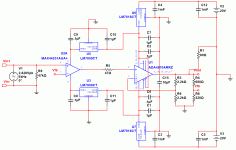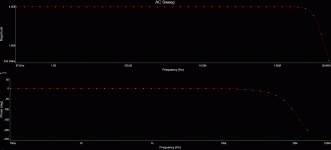Sure the specified THD is good, but then driving 2 Vpp (0.7 Vrms) into 10 kOhms is not exactly what I'd call a heavy load either. CMRR vs. frequency (thankfully specified) does not look all that great, being down to little more to 50 dB by 10 kHz. Is that even any better than a 5532? (Input noise certainly is in the same ballpark in both e_n and i_n. The 35-year-old part obviously needs 4 times as much current, but who really cares in this application, besides it could run on the same set of supplies.) Their MAX44267 will do 80 dB at this point, for example, an OPA1642 over 100 dB, and an OPA1612 can keep 120 dB up to almost 100 kHz. Common-mode rejection is directly tied to common-mode distortion, and given the low gains that headphone amps tend to be running at that's definitely a consideration.
Nobody really needs DC coupling throughout for audio. If anything, it's more of a risk than anything else, allowing rogue DC on the input to propagate to your load.
The power supply setup would still need some work. Using big 1 A 78xx/79xx regs at little more than 2 mA of load with precious little capacitance on the output... yeah right. Hint: If you need an 78L series reg, use one. And don't skimp on output capacitance. If you need low output impedance and low noise at low currents, a shunt regulator may prove the better option. Or, hell, an opamp with a filtered voltage divider if you're coming from a regulated supply anyway.
Nobody really needs DC coupling throughout for audio. If anything, it's more of a risk than anything else, allowing rogue DC on the input to propagate to your load.
The power supply setup would still need some work. Using big 1 A 78xx/79xx regs at little more than 2 mA of load with precious little capacitance on the output... yeah right. Hint: If you need an 78L series reg, use one. And don't skimp on output capacitance. If you need low output impedance and low noise at low currents, a shunt regulator may prove the better option. Or, hell, an opamp with a filtered voltage divider if you're coming from a regulated supply anyway.
You are right about the supplies. Perhaps I should have simply placed voltage labels there to obfuscate things a bit more, this is not a good excuse for including the 79xxs in the schematic, but i'd certainly replace them with more appropriate regulators. I've got a whole bunch of LM329s that would happily build some decent low impedance regulators that I wouldnt want to complicate this schematic with.
The CMRR passes the 60dB point at what, 4.5kHz? 40dB at 40kHz.
44.1kHz sample rates on digital audio for sure introduces more crap in these frequency ranges than any common-mode noise coupling in there over shielded interconnects and half decent layout.
Thinking in the mode that nobody really needs DC-coupling is what leads to; say, after you've bought your DAC, preamp, poweramp, etc, the product of several cascaded high-pass filters within these various devices making the true -3dB corner frequency somewhere in the 20Hz range. Yeah, some AC-coupling is just fine, but it can become a real PITA really fast.
The CMRR passes the 60dB point at what, 4.5kHz? 40dB at 40kHz.
44.1kHz sample rates on digital audio for sure introduces more crap in these frequency ranges than any common-mode noise coupling in there over shielded interconnects and half decent layout.
Thinking in the mode that nobody really needs DC-coupling is what leads to; say, after you've bought your DAC, preamp, poweramp, etc, the product of several cascaded high-pass filters within these various devices making the true -3dB corner frequency somewhere in the 20Hz range. Yeah, some AC-coupling is just fine, but it can become a real PITA really fast.
"what headphone"? is the big question for Vswing, Iout needed
and if noise limits too much for just about anything else to matter - as with sensitive iem that hit >120 dB SPL with 200 mVrms
assuming you need the I, V then there's still lots to work on - Class AB nonlinear PS currents will give give distortion from magnetic and common gnd impedance coupling without care during layout
the ADA4870 probably wants lower parasitic L bypass, 10 nF or 1 nF, or even "broadside" packaging - ugg the DS 22uF Tant, 0.1 uF PS bypass is totally dated, should be ignored
the output likely needs series decoupling Z - sub uH air coil may work with little added distortion, add the recommended Rs in parallel
and if noise limits too much for just about anything else to matter - as with sensitive iem that hit >120 dB SPL with 200 mVrms
assuming you need the I, V then there's still lots to work on - Class AB nonlinear PS currents will give give distortion from magnetic and common gnd impedance coupling without care during layout
the ADA4870 probably wants lower parasitic L bypass, 10 nF or 1 nF, or even "broadside" packaging - ugg the DS 22uF Tant, 0.1 uF PS bypass is totally dated, should be ignored
the output likely needs series decoupling Z - sub uH air coil may work with little added distortion, add the recommended Rs in parallel
Yes, I agree jcx we only have the 80R load on the schematic to narrow down the possibilities about what its intended to drive.
The non-linear currents are a major challenge to keep under control in my experience. Seeing as the ADA4870 is dissipating about 1.2W quiescent in this application, how about going fully classA? I doubt that it'll be less efficient overall than what you're currently proposing but would be a fairly major architectural change. The downside of classA would be less tolerance of varying loads (meaning changes of headphones, they come in a very wide range of impedances) - but then transformers can come to the rescue.
The non-linear currents are a major challenge to keep under control in my experience. Seeing as the ADA4870 is dissipating about 1.2W quiescent in this application, how about going fully classA? I doubt that it'll be less efficient overall than what you're currently proposing but would be a fairly major architectural change. The downside of classA would be less tolerance of varying loads (meaning changes of headphones, they come in a very wide range of impedances) - but then transformers can come to the rescue.
Try this amp if you want to drive DT770-250 or DT880-250's nicely. Pure class A and two transistors.
http://www.diyaudio.com/forums/group-buys/302859-xrk971-pocket-class-headamp-gb.html
Here is a list of cans people say it sounds great with:
- AKG K240 (Bogde)
- HD600 with Apollo 8 Blackface (John H. personal communication to xrk971)
- LCD-2 (70ohm) (Morde)
- DT990 pro (Bogde)
- DT880-250 with Focusrite Solo 2G (xrk971)
- DT770-250 (pcgab)
- MA900 (Bogde)
- MDRV6 with Focusrite Solo 2G (xrk971)
- HD800 (modified) with Yggdrasil (Funch)
- HD598-50 (StellarElephant)
- HD598Cs (Bogde)
- HE400i (bogde) (Tidal HiFi > Fiio X3ii)
- AKG Q701 (bogde) (Tidal HiFi > Fiio X3ii)
http://www.diyaudio.com/forums/group-buys/302859-xrk971-pocket-class-headamp-gb.html
Here is a list of cans people say it sounds great with:
- AKG K240 (Bogde)
- HD600 with Apollo 8 Blackface (John H. personal communication to xrk971)
- LCD-2 (70ohm) (Morde)
- DT990 pro (Bogde)
- DT880-250 with Focusrite Solo 2G (xrk971)
- DT770-250 (pcgab)
- MA900 (Bogde)
- MDRV6 with Focusrite Solo 2G (xrk971)
- HD800 (modified) with Yggdrasil (Funch)
- HD598-50 (StellarElephant)
- HD598Cs (Bogde)
- HE400i (bogde) (Tidal HiFi > Fiio X3ii)
- AKG Q701 (bogde) (Tidal HiFi > Fiio X3ii)
LM7818 will not regulate with 20.0V input (I realize this is only a sketch).
I know very very few headphones which need more than +/-9V rails (with a nearly r-r amp*) to blow your ears out.
(*) Working resistor loaded, as in amps xrk971 and I have built, higher rails may be needed. Resistance-coupled amplifiers are only 6% efficient, and for reasonable heat won't swing P-P more than 0.6 of supply in optimum load, less over the wide range of loads we find. I had a 30V supply and big fins, and still not enough for "insane" levels (live monitoring in the concert hall). I shifted to a push-pull which would swing most of 24V, and that never clipped even in hi-Z phones.
I know very very few headphones which need more than +/-9V rails (with a nearly r-r amp*) to blow your ears out.
(*) Working resistor loaded, as in amps xrk971 and I have built, higher rails may be needed. Resistance-coupled amplifiers are only 6% efficient, and for reasonable heat won't swing P-P more than 0.6 of supply in optimum load, less over the wide range of loads we find. I had a 30V supply and big fins, and still not enough for "insane" levels (live monitoring in the concert hall). I shifted to a push-pull which would swing most of 24V, and that never clipped even in hi-Z phones.
- Status
- This old topic is closed. If you want to reopen this topic, contact a moderator using the "Report Post" button.
- Home
- Amplifiers
- Headphone Systems
- This seems like a good amplifier... tell me I'm wrong.

